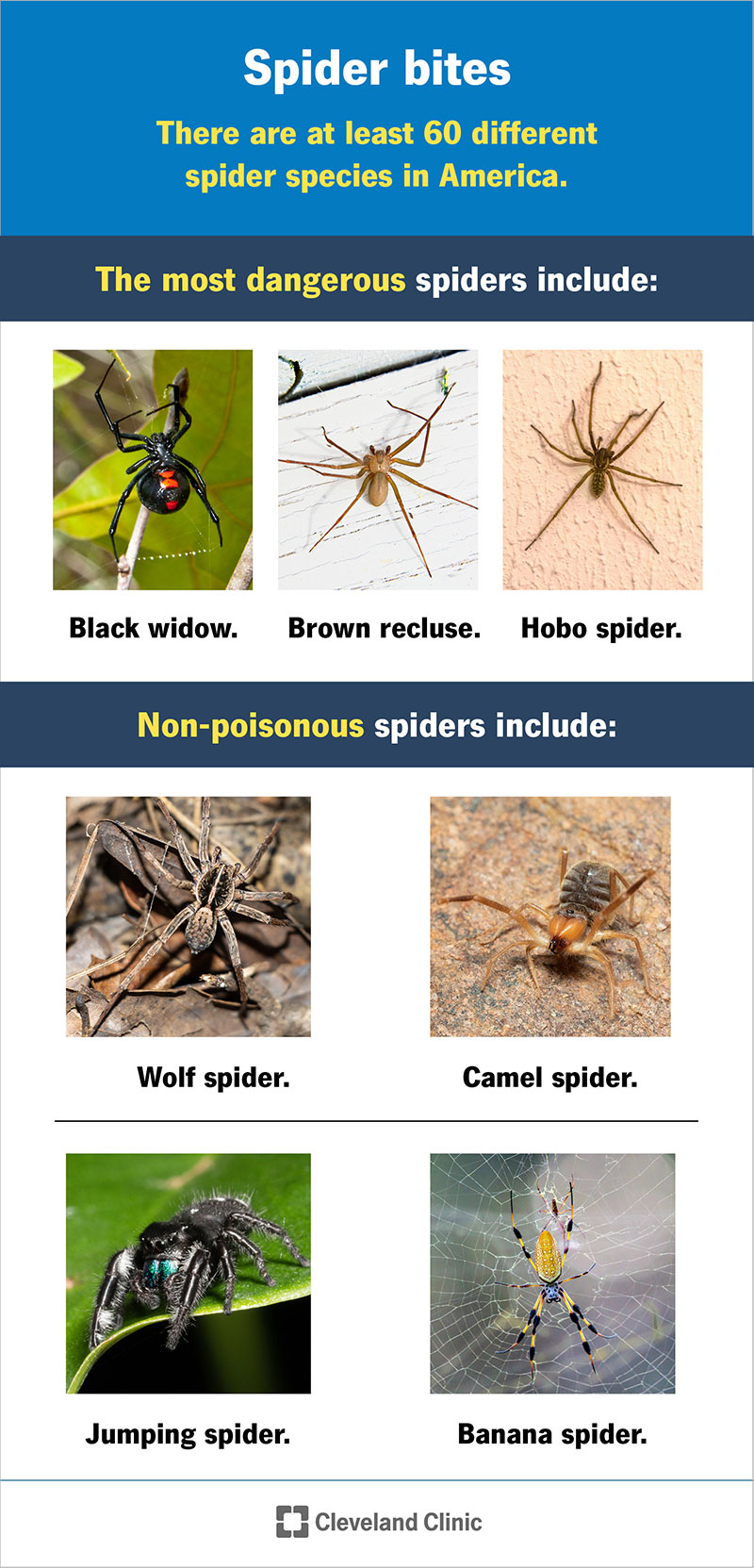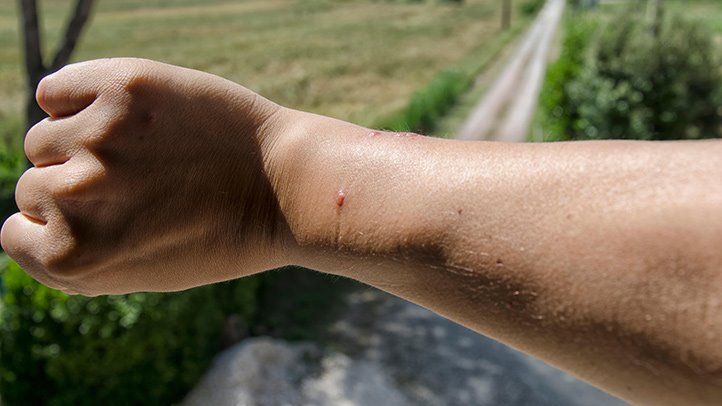To determine if a spider bite is poisonous, look for symptoms such as intense pain, swelling, redness, and difficulty breathing. If you experience these symptoms after a spider bite, seek medical attention immediately.
Spider bites can range from mild irritation to severe poisoning, so it’s crucial to monitor any unusual symptoms and seek professional medical advice if necessary. Spider bites can be a cause for concern due to the potential for venomous effects.
While most spider bites result in minor symptoms, some can lead to severe health issues. Understanding the signs of a poisonous spider bite can help you identify when to seek medical help. In this blog, we will explore the key indicators of a poisonous spider bite, how to differentiate it from a non-poisonous bite, and what actions to take if you suspect you’ve been bitten by a venomous spider. By the end of this article, you’ll have a clear understanding of how to assess the severity of a spider bite and the necessary steps to ensure your well-being.

Credit: my.clevelandclinic.org
Introduction To Spider Bites
Spider bites can be a cause for concern due to the potential for venomous effects. Understanding the signs of a poisonous spider bite is crucial for prompt and appropriate medical attention. This article will debunk common misconceptions about spider bites and emphasize the importance of proper identification.
Common Misconceptions
One common misconception is attributing any unidentified skin irritation to a spider bite. This often leads to unnecessary anxiety and inappropriate treatment.
Why Identification Matters
Accurate identification of spider bites is vital as it enables targeted medical intervention and appropriate management. This helps to prevent unnecessary alarm and ensures the right course of action is taken.
Types Of Spiders To Watch Out For
When it comes to spider bites, being able to identify the type of spider that bit you is crucial in determining if the bite is poisonous.
Black Widow
The Black Widow spider is known for its shiny black body with a red hourglass shape on its abdomen.
Brown Recluse
The Brown Recluse spider is identified by its brown color and a violin-shaped mark on its back.
Immediate Signs Of A Poisonous Bite
Immediate signs of a poisonous spider bite include severe pain, swelling, redness, and itching around the bite area. Other symptoms can include muscle cramps, nausea, vomiting, and difficulty breathing. It is important to seek medical attention immediately if you experience any of these symptoms after a spider bite.
If you have been bitten by a spider, it’s essential to know whether it’s poisonous or not. Immediate signs of a poisonous spider bite can help you identify the danger and seek medical attention. The following are some of the symptoms that indicate a poisonous spider bite.Pain And Swelling
One of the immediate signs of a poisonous spider bite is pain and swelling around the bite area. The severity of the pain and swelling can vary depending on the type of spider that bit you. In some cases, the pain can be excruciating, and the swelling can spread to the surrounding areas, making it difficult to move the affected limb.Redness And Warmth
Another sign of a poisonous spider bite is redness and warmth around the bite area. The area may feel warm to the touch, and the skin can turn red due to the inflammation caused by the spider’s venom. In some cases, the redness can spread to the surrounding areas, indicating that the venom has entered the bloodstream.If you experience any of the above symptoms, it’s crucial to seek medical attention immediately. Delay in treatment can lead to severe complications, such as tissue damage, organ failure, and even death. Remember that not all spider bites are poisonous, but it’s always better to be safe than sorry.What To Do If You Get Bitten By A Spider
If you get bitten by a spider, it’s essential to follow these steps:- Wash the bite area with soap and water.
- Apply a cold compress to reduce swelling and pain.
- Keep the affected limb elevated to prevent the venom from spreading.
- Seek medical attention immediately, especially if you experience any of the immediate signs of a poisonous spider bite.
Systemic Symptoms To Be Aware Of
When it comes to spider bites, it’s important to be aware of the systemic symptoms that may indicate a poisonous bite. While most spider bites are harmless and cause only localized symptoms such as redness and itching, certain species of spiders can inject venom that affects the entire body. These systemic symptoms can be more severe and require immediate medical attention. Here are two key systemic symptoms to be aware of:
Nausea And Vomiting
If you experience nausea and vomiting after a spider bite, it could be a sign of a poisonous bite. The venom from certain spider species can affect the digestive system, leading to these uncomfortable symptoms. If you notice persistent or worsening nausea and vomiting, it’s crucial to seek medical help to determine the appropriate treatment.
Muscle Cramps And Weakness
Another systemic symptom to watch out for is muscle cramps and weakness. Certain spider venoms can affect the neuromuscular system, causing muscle spasms, cramps, and overall weakness. If you experience any unusual muscle symptoms following a spider bite, it’s important to consult a healthcare professional for evaluation and potential treatment.
Differences Between Poisonous And Non-poisonous Bites
When dealing with spider bites, it’s crucial to distinguish between poisonous and non-poisonous bites. Understanding the differences can help in timely medical intervention and appropriate treatment.
Appearance
Identifying the appearance of the bite can be a key indicator. Poisonous spider bites often appear as two puncture marks and may be surrounded by redness and swelling. In contrast, non-poisonous bites may cause redness and mild swelling, but they typically don’t have the distinctive pair of puncture marks.
Symptom Progression
The progression of symptoms also sets poisonous and non-poisonous bites apart. Poisonous bites may lead to severe symptoms such as muscle pain, cramping, sweating, and difficulty breathing. On the other hand, non-poisonous bites usually result in localized pain, redness, and mild swelling, with symptoms staying relatively mild.
First Aid Measures
Spiders are a common creature that can be found almost everywhere. While most spider bites are harmless, some can be poisonous and require immediate medical attention. It’s important to know how to identify a poisonous spider bite and what first aid measures to take to prevent further harm.
Cleaning The Wound
If you or someone around you has been bitten by a spider, the first step is to clean the wound thoroughly. Use soap and water to wash the affected area and remove any dirt or debris. This will help prevent infection and minimize the risk of complications.
When To Seek Medical Attention
After cleaning the wound, monitor the affected area for any signs of a poisonous spider bite. These may include swelling, redness, and severe pain. If you experience any of these symptoms, seek medical attention immediately.
If the bite is from a black widow or brown recluse spider, it’s important to seek medical attention right away. These spiders are highly poisonous and can cause serious health complications if left untreated.
Summary
- Wash the affected area with soap and water to prevent infection.
- Monitor the bite for any signs of poisoning such as swelling, redness, and severe pain.
- Seek medical attention immediately if you experience any of these symptoms.
Remember, it’s always better to be safe than sorry. If you’re unsure whether a spider bite is poisonous or not, seek medical attention right away. With the right first aid measures and prompt medical attention, most spider bites can be treated effectively.
Prevention Tips
If you suspect a spider bite, watch for symptoms like redness, swelling, pain, and itching. Seek medical attention immediately if you experience difficulty breathing, muscle spasms, or severe abdominal pain. It’s crucial to identify the spider and get prompt treatment if the bite is poisonous.
Safe Practices At Home
Maintain cleanliness to prevent spiders from nesting.
Seal cracks and crevices where spiders can enter.
Protective Clothing
Wear long sleeves and pants in spider-prone areas.
Use gloves when handling firewood or debris outdoors.

Credit: www.facebook.com
When To Consult A Doctor
When to Consult a Doctor:
Symptom Severity
If symptoms worsen or include severe pain, redness, or swelling, seek medical attention.
Risk Factors For Complications
Individuals with weakened immune systems or allergic reactions should see a doctor promptly.
:max_bytes(150000):strip_icc()/spiderbitefinal-5a2ff7229e94270037bb4efa.png)
Credit: www.verywellhealth.com
Frequently Asked Questions
Can A Spider Bite Be Poisonous?
Yes, some spider bites can be poisonous. However, most spider bites are harmless and cause only mild irritation or discomfort. It is important to identify the type of spider and seek medical attention if symptoms worsen or if you suspect a poisonous spider bite.
How Do You Know If A Spider Bite Is Poisonous?
The symptoms of a poisonous spider bite may include severe pain, swelling, redness, and the formation of a blister or ulcer at the site of the bite. Other signs can include muscle pain, headache, nausea, and fever. If you experience these symptoms after a spider bite, seek immediate medical attention.
What Should I Do If I Get Bitten By A Spider?
If you are bitten by a spider, clean the bite area with soap and water. Apply a cold compress to reduce swelling and take over-the-counter pain relievers if necessary. Monitor the bite site for any signs of infection or worsening symptoms.
If symptoms persist or worsen, seek medical attention promptly.
How Long Does It Take For A Spider Bite To Heal?
The healing time for a spider bite can vary depending on the severity and type of spider. Mild bites may heal within a few days to a week, while more severe bites can take several weeks to heal completely. It is important to keep the area clean and monitor for any signs of infection during the healing process.
Conclusion
By being aware of symptoms and seeking medical help promptly, you can determine the severity of a spider bite. Understanding the signs of a poisonous spider bite is crucial for timely treatment and recovery. Stay informed and prioritize your health in dealing with spider bites.
Related posts:

I’m MD Tanvir, and I bring years of expertise gained from working closely with pest control companies to the forefront. My journey in the industry has inspired me to launch Bug Battler, a platform aimed at equipping people with the know-how to combat pests autonomously. Through Bug Battler, I aim to empower individuals with practical insights to tackle pest infestations effectively.

